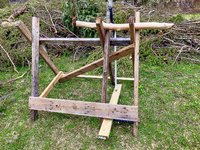Recycling/repurposing.

My old Darkroom print developing trays getting a second life as seedling trays. Sitting in a sunny south facing window. The trays were up in the attic for, ahem, a few years, but I remembered where they were and dragged them out. This is our first batch of seedlings started this year. They were all started the same time in one of those seed starter trays with a cover. It seems to work best when I put it downstairs near the wood stove. They sprout sooner than the number of days indicated on the seed package. The most striking thing is the rate of growth by the cucumbers compared to everything else. They had the biggest seeds and were the first to sprout. The tomatoes on the far right are far behind by comparison. Looking forward to getting the greenhouse going again.
My old Darkroom print developing trays getting a second life as seedling trays. Sitting in a sunny south facing window. The trays were up in the attic for, ahem, a few years, but I remembered where they were and dragged them out. This is our first batch of seedlings started this year. They were all started the same time in one of those seed starter trays with a cover. It seems to work best when I put it downstairs near the wood stove. They sprout sooner than the number of days indicated on the seed package. The most striking thing is the rate of growth by the cucumbers compared to everything else. They had the biggest seeds and were the first to sprout. The tomatoes on the far right are far behind by comparison. Looking forward to getting the greenhouse going again.



 I hope you post some images of the flutes, and maybe even video of what they sound like.
I hope you post some images of the flutes, and maybe even video of what they sound like.
